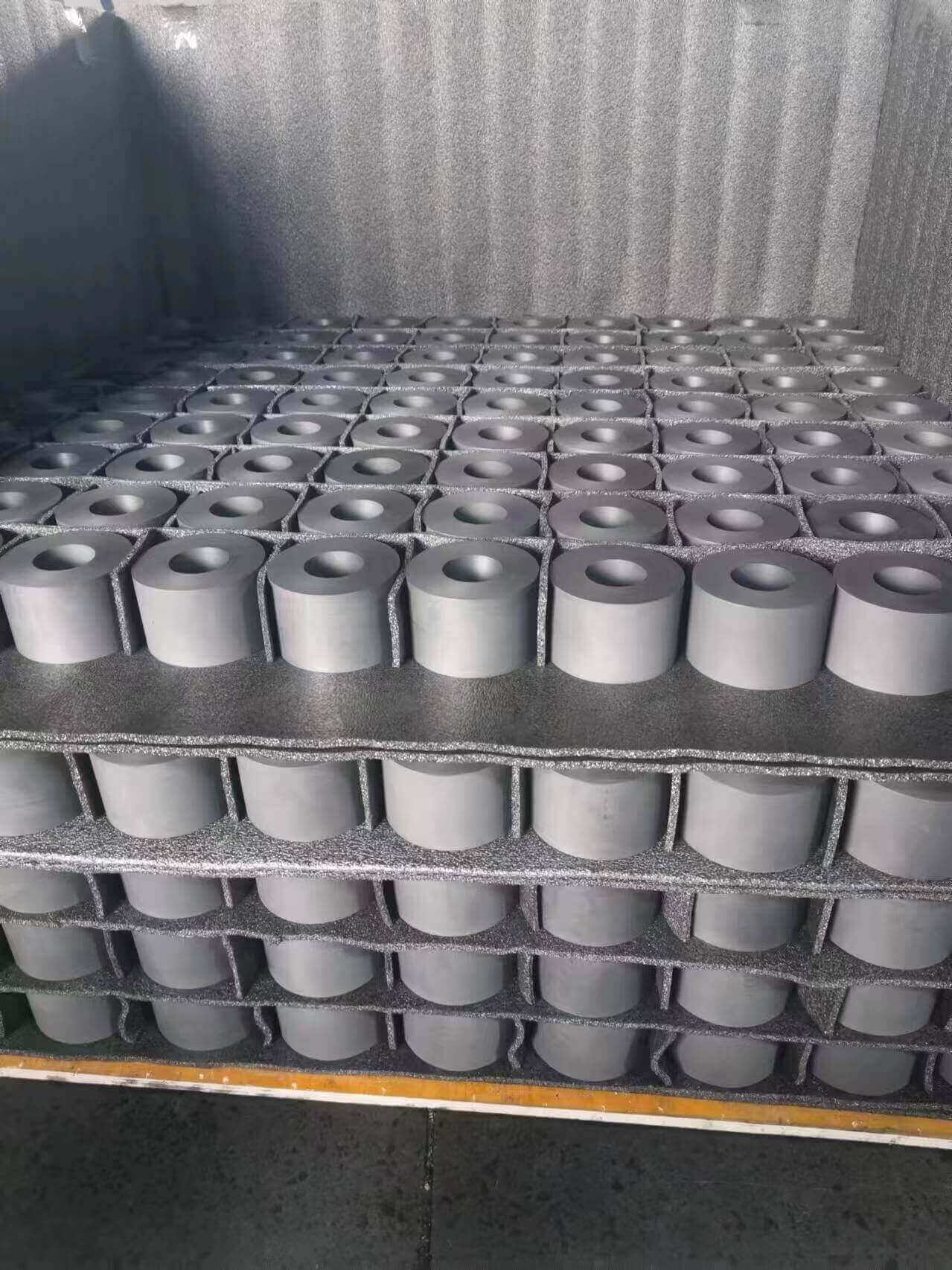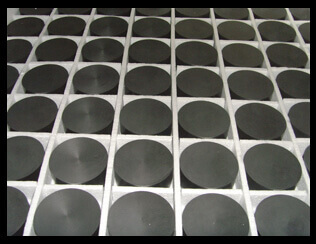High-purity graphite with carbon content>99.99%. High purity graphite has the advantages of high temperature resistance, corrosion resistance, thermal shock resistance, small coefficient of thermal expansion, self-lubricating, small resistivity and easy machining, etc. it is widely used in metallurgy, machinery, environmental protection, Medicine, military, aerospace and other fields, It plays a very important role in the national economy, especially in the solar photovoltaic industry. The average annual growth rate of Global solar photovoltaic industry is of 40%, and China shares 70% of the world, as the world’s largest producer of solar photovoltaic. this industry in 2011 consumes high-grade graphite material upto 23,000 tons or more, and iis expected in the future photovoltaic industry Monocrystalline silicon and polysilicon

high purity isostatic graphite rods blocks rounds blocks material manufacturer factory China (1)
demand for high-purity graphite materials will have an annual growth rate of 20% to 25%. At present, China’s graphite industry is still in the world’s low-level grade, products are mainly raw materials and primary processing products, high impurities in the product make it limited to less applications. Therefore, on the one hand, low prices of China’s graphite has lead to large volume of exportation; the other hand, the domestic market needs high purity ultra-fine graphite products, which are mainly imported from abroad. In summary, to carry out high-purity graphite production technology research, and improve product quality, is very importand to China’s high-purity graphite industry.
- high-purity graphite production process:
The production process of high-purity graphite and graphite electrode production process is different. High purity graphite requires isotropic raw materials,need to mill raw materials into a more fine powder, need to use isostatic pressing technology, the baking cycle is long, in order to achieve the deired density, it requires multiple impregnation – baking cycle, and the Graphitization cycle is also much longer than ordinary graphite
1.1 raw materials
The raw materials for production of high purity graphite, including aggregates, adhesives and impregnating material. Aggregates are usually made of needle petroleum coke and pitch coke. This is because the needle-like petroleum coke has low ash content (generally less than 1%), easy to be graphitized at high temperature, good electrical and thermal conductivity, small linear expansion coefficient and the like; With pitch coke, even that graphite obtained at the same graphitization temperature , it has higher resistivity, and higher mechanical strength, so the general production of graphitized products, in addition to petroleum coke, there is also a certain percentage of pitch coke in order to improve the mechanical strength of the product. Binder usually use coal tar, it is coal tar distillation process of the product, at room temperature for the black solid, no fixed melting point. According to the different equipment conditions and technological requirements of each enterprise, the softening point of coal tar pitch is from 50 ℃ to 250 ℃. Generally, high purity or high temperature coal tar pitch is selected for the production of high purity graphite products. The impregnant is essentially the same as the binder. It is required to increase the bulk density, impermeability, lubricity, strength and other special properties of the product. It is required to add the impregnating

high purity isostatic graphite rods blocks rounds blocks material manufacturer factory China (7)
material after baking, graphitizing or machining.
1.2 Calcination / purification
selected aggregates, because of their coking temperature or coal age is different, it contains water, impurities or volatile matter in the internal structure in some degree. if we don’t pre-excluded these substances, and use Them to produce graphite material directly, this will affect the product quality and performance, so we should do the calcination or purification process for the selected aggregate. Calcination is heat treatment for a variety of solid carbon raw materials in the isolated air conditions under high temperature. In the low-temperature drying stage, mainly to exclude moisture; in the volatile phase of the discharge phase, mainly to complete the decomposition of aromatic compounds in raw materials, and complete the condensation of certain compounds. Purification is mainly to remove some impurities. At present, the method of purification of graphite at home and abroad mainly flotation, alkali acid, hydrofluoric acid, chlorination roasting, high temperature and so on.
1.3 milling
for graphite production of solid materials, although the calcination or purification of the block size has been reduced, but the particle size is still relatively large, and volatile, non-uniform composition, the need to crush aggregate size requirements to the ingredients. High-purity graphite aggregate size is usually to reach 20μm. At present, a vertical roller mill is used for grinding the powder having an average particle size of 10 to 20 μm.
1.4 Pellet
the milled powder, which is dispersible and non-uniform. It needs to be mixed with the coal tar pitch binder according to a certain proportion and then put into the heating type kneading machine to mix and knead to make the material evenly distributed and make the adhesive evenly and thinly wrapped on the surface of the powder particle and penetrate and infiltrate into the surface of the powder particle .
1.5 Molding
At present, there are many carbon forming methods, the main methods are extrusion molding, molding, vibration molding, isostatic pressing. High-purity graphite production using the method of isostatic pressing, it has cold isostatic pressing and hot isostatic pressing. Isostatic molding is the material placed in the soft mold, dense, sealed after vacuum, into the isostatic press cylinder, the mold outside the liquid at the same pressure from all directions on the role of the mold, pressed into cylindrical Or a rectangular product. The obtained product has isotropic structure and performance, which is the biggest advantage of isostatic graphite products.
1.6 Baking
After calcination of carbon products, it goes to baking process, that is, make the raw material blocks in isolation environment, after the heat treatment (about 1000 ℃), so that the binder is charred into binder coke. This is a slow process, the whole process is divided into several stages, each stage of a series of physical and chemical reactions, including carbon aggregate surface to generate a certain thickness of the binder film, binder liquid migration, asphalt vapor Capillary condensation, gasification and surface diffusion.
1.7 Impregnation
The purpose of impregnation is to impregnate the impregnating agent, such as molten asphalt, into the tiny pores formed in the product during the calcination process and the open pores existing in the aggregate coke particles to improve the bulk density, electrical conductivity, mechanical strength, Chemical corrosion and so on. Impregnation is generally carried out by pressure impregnation, the product must first be preheated, and then vacuum degassing in the impregnation tank, then add the good coal tar pitch impregnation tank, the pressure to make impregnating agent asphalt into the interior
1.8 Graphitization
Graphitization refers to the high-temperature heat treatment process to make thermodynamically unstable non-graphitic carbon by thermal activation into graphite. Carbon baked goods by 2000 ~ 2800 ℃ high-temperature graphitization, the carbon product chaotic layer structure of carbon atoms lattice, into a three-dimensional ordered layered structure, while removing impurities. Graphitization methods are Acheson method, internal heat series method, intermediate frequency induction method.
CFCCARBON LTD can produce all types of graphite materials, and we have overseas graphite materials from Japan, France, USA. We specialize in precise graphite machining. We are capable of machining different types of graphite, such as graphite rods, graphite blocks, graphite boats, graphite pipes, graphite plates, graphite bearing, graphite heating elements, Vacuum heating furnace, Silicon thermal field, graphite crucibles and other parts from a wide range of applications.
Good reputation, reliable quality, best service and high technologies are our eternal objectives!
Hope we can be your partners soon. We will serve you with our quality products and top technologies and benefit each other.
related news /articles:
Characteristics and applications of high-purity graphite crucible
graphite rods, graphite blocks
Big promotion for isostatic graphite rods, size D100-400mm